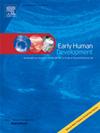中欧人群中2D:4D手指比例与握力之间的关系
IF 2
3区 医学
Q2 OBSTETRICS & GYNECOLOGY
引用次数: 0
摘要
2D:4D比例指的是第二指(2D)和第四指(4D)的相对长度,代表了在产前发育过程中建立的两性二态特征。它被广泛认为是胎儿雄激素暴露的间接标志,尤其是睾酮。与食指相比,子宫内睾丸激素水平升高与无名指生长加快有关,这导致2D:4D比更低。同样,握力受产前睾丸激素水平的影响,反映了个人的整体身体健康和肌肉质量。本研究调查了年龄均匀的中欧大学生的2D:4D比率和握力之间的关系,年龄在18至32岁(n = 203;男性99人,女性104人)。统计分析证实,女性双手的手指比例明显高于男性,这支持了可能由产前激素影响形成的性别差异。与女性相比,男性表现出更大的握力,这反映了基于性别的体力二态性。这项研究的发现还支持了一个假设,即较低的左右2D:4D比率(被认为是产前睾酮暴露增加的一个指标)与更大的握力有关。这种相关性在右撇子中最为明显,尤其是在男性和右撇子参与者中。手指比与体力的关系模式因性别而异,男性呈u型关系,而女性呈倒u型关系。总的来说,这项研究重复并扩展了之前的研究结果,从而有助于更好地理解手指比例作为雄激素相关性状的潜在生物标志物,特别是与体力有关的指标。本文章由计算机程序翻译,如有差异,请以英文原文为准。
Associations between 2D:4D digit ratio and handgrip strength in a Central European population
The 2D:4D ratio refers to the relative lengths of the second (2D) and fourth (4D) fingers and represents a sexually dimorphic trait that is established during prenatal development. It is widely regarded as an indirect marker of fetal androgen exposure, particularly testosterone. Elevated testosterone levels in utero are associated with increased growth of the ring finger compared to the index finger, which leads to a lower 2D:4D ratio. Similarly, handgrip strength is influenced by prenatal testosterone levels and reflects an individual's overall physical fitness and muscle mass. The present study investigated the relationship between 2D:4D ratios and handgrip strength in an age-homogeneous sample of Central European university students aged 18 to 32 years (n = 203; 99 males, 104 females). Statistical analyses confirmed that females exhibited significantly higher digit ratios than males on both hands, supporting established sex differences likely shaped by prenatal hormonal influences. Males demonstrated substantially greater handgrip strength compared to women, reflecting an established sex-based physical dimorphism in physical strength. The findings of this study additionally support the hypothesis that a lower left and right 2D:4D ratio, considered an indicator of increased prenatal testosterone exposure, is associated with greater handgrip strength. This correlation was most pronounced in the right hand, particularly among male and right-handed participants. The pattern of the relationship between digit ratio and physical strength differed by sex, with males exhibiting a U-shaped association and females showing an inverted U-shaped relationship. Overall, this study replicates and extends previous findings and thereby contributes to a better understanding of digit ratio as a potential biomarker for androgen-related traits, especially in connection with physical strength.
求助全文
通过发布文献求助,成功后即可免费获取论文全文。
去求助
来源期刊

Early human development
医学-妇产科学
CiteScore
4.40
自引率
4.00%
发文量
100
审稿时长
46 days
期刊介绍:
Established as an authoritative, highly cited voice on early human development, Early Human Development provides a unique opportunity for researchers and clinicians to bridge the communication gap between disciplines. Creating a forum for the productive exchange of ideas concerning early human growth and development, the journal publishes original research and clinical papers with particular emphasis on the continuum between fetal life and the perinatal period; aspects of postnatal growth influenced by early events; and the safeguarding of the quality of human survival.
The first comprehensive and interdisciplinary journal in this area of growing importance, Early Human Development offers pertinent contributions to the following subject areas:
Fetology; perinatology; pediatrics; growth and development; obstetrics; reproduction and fertility; epidemiology; behavioural sciences; nutrition and metabolism; teratology; neurology; brain biology; developmental psychology and screening.
 求助内容:
求助内容: 应助结果提醒方式:
应助结果提醒方式:


